MITSUBISHI GRANDIS 2008 Owner's Manual (in English)
Manufacturer: MITSUBISHI, Model Year: 2008, Model line: GRANDIS, Model: MITSUBISHI GRANDIS 2008Pages: 458, PDF Size: 18.52 MB
Page 171 of 458
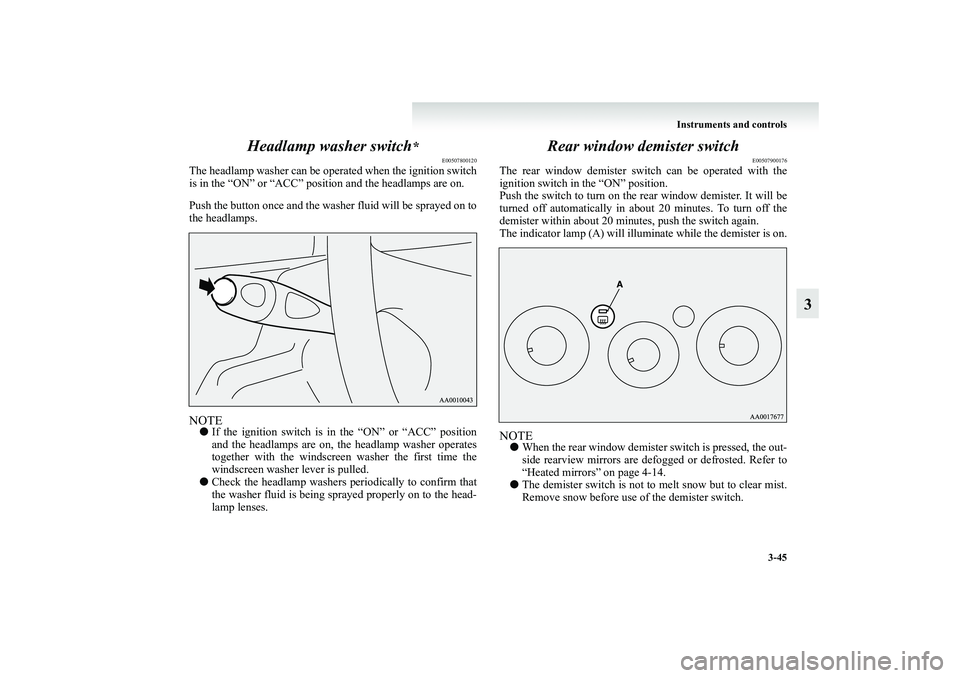
Instruments and controls
3-45
3 Headlamp washer switch
*
E00507800120
The headlamp washer can be operated when the ignition switch
is in the “ON” or “ACC” position and the headlamps are on.
Push the button once and the washer fluid will be sprayed on to
the headlamps.NOTE●If the ignition switch is in the “ON” or “ACC” position
and the headlamps are on, the headlamp washer operates
together with the windscreen washer the first time the
windscreen washer lever is pulled.
â—ŹCheck the headlamp washers periodically to confirm that
the washer fluid is being sprayed properly on to the head-
lamp lenses.
Rear window demister switch
E00507900176
The rear window demister switch can be operated with the
ignition switch in the “ON” position.
Push the switch to turn on the rear window demister. It will be
turned off automatically in about 20 minutes. To turn off the
demister within about 20 minutes, push the switch again.
The indicator lamp (A) will illuminate while the demister is on.NOTEâ—ŹWhen the rear window demister switch is pressed, the out-
side rearview mirrors are defogged or defrosted. Refer to
“Heated mirrors” on page 4-14.
â—ŹThe demister switch is not to melt snow but to clear mist.
Remove snow before use of the demister switch.
BK-XP08E1ENUK.en-uk.book Page 45 Monday, August 13, 2007 2:20 PM
Page 172 of 458
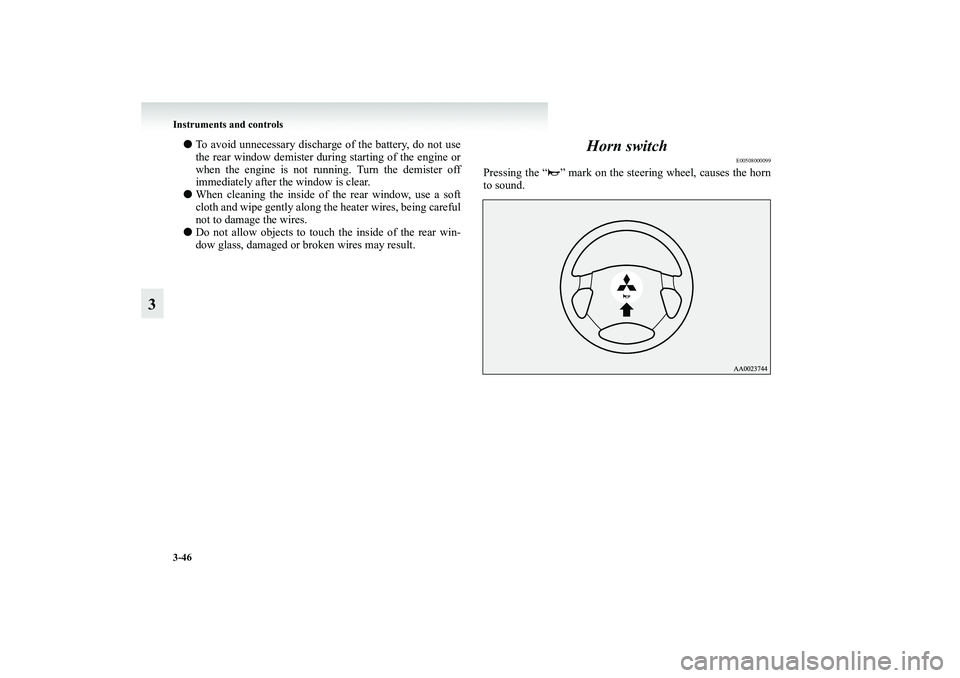
3-46 Instruments and controls
3
â—ŹTo avoid unnecessary discharge of the battery, do not use
the rear window demister during starting of the engine or
when the engine is not running. Turn the demister off
immediately after the window is clear.
â—ŹWhen cleaning the inside of the rear window, use a soft
cloth and wipe gently along the heater wires, being careful
not to damage the wires.
â—ŹDo not allow objects to touch the inside of the rear win-
dow glass, damaged or broken wires may result.
Horn switch
E00508000099
Pressing the “ ” mark on the steering wheel, causes the horn
to sound.
BK-XP08E1ENUK.en-uk.book Page 46 Monday, August 13, 2007 2:20 PM
Page 173 of 458
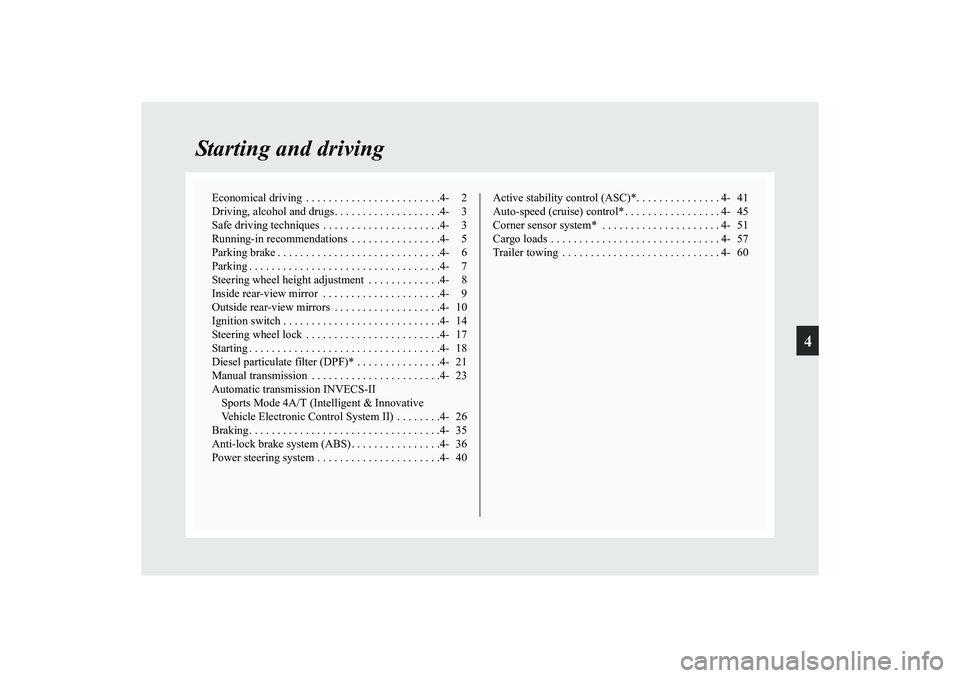
4
Starting and driving
Economical driving . . . . . . . . . . . . . . . . . . . . . . . .4- 2
Driving, alcohol and drugs. . . . . . . . . . . . . . . . . . .4- 3
Safe driving techniques . . . . . . . . . . . . . . . . . . . . .4- 3
Running-in recommendations . . . . . . . . . . . . . . . .4- 5
Parking brake . . . . . . . . . . . . . . . . . . . . . . . . . . . . .4- 6
Parking . . . . . . . . . . . . . . . . . . . . . . . . . . . . . . . . . .4- 7
Steering wheel height adjustment . . . . . . . . . . . . .4- 8
Inside rear-view mirror . . . . . . . . . . . . . . . . . . . . .4- 9
Outside rear-view mirrors . . . . . . . . . . . . . . . . . . .4- 10
Ignition switch . . . . . . . . . . . . . . . . . . . . . . . . . . . .4- 14
Steering wheel lock . . . . . . . . . . . . . . . . . . . . . . . .4- 17
Starting . . . . . . . . . . . . . . . . . . . . . . . . . . . . . . . . . .4- 18
Diesel particulate filter (DPF)* . . . . . . . . . . . . . . .4- 21
Manual transmission . . . . . . . . . . . . . . . . . . . . . . .4- 23
Automatic transmission INVECS-II
Sports Mode 4A/T (Intelligent & Innovative
Vehicle Electronic Control System II) . . . . . . . .4- 26
Braking. . . . . . . . . . . . . . . . . . . . . . . . . . . . . . . . . .4- 35
Anti-lock brake system (ABS) . . . . . . . . . . . . . . . .4- 36
Power steering system . . . . . . . . . . . . . . . . . . . . . .4- 40Active stability control (ASC)*. . . . . . . . . . . . . . . 4- 41
Auto-speed (cruise) control* . . . . . . . . . . . . . . . . . 4- 45
Corner sensor system* . . . . . . . . . . . . . . . . . . . . . 4- 51
Cargo loads . . . . . . . . . . . . . . . . . . . . . . . . . . . . . . 4- 57
Trailer towing . . . . . . . . . . . . . . . . . . . . . . . . . . . . 4- 60
BK-XP08E1ENUK.en-uk.book Page 1 Monday, August 13, 2007 2:20 PM
Page 174 of 458
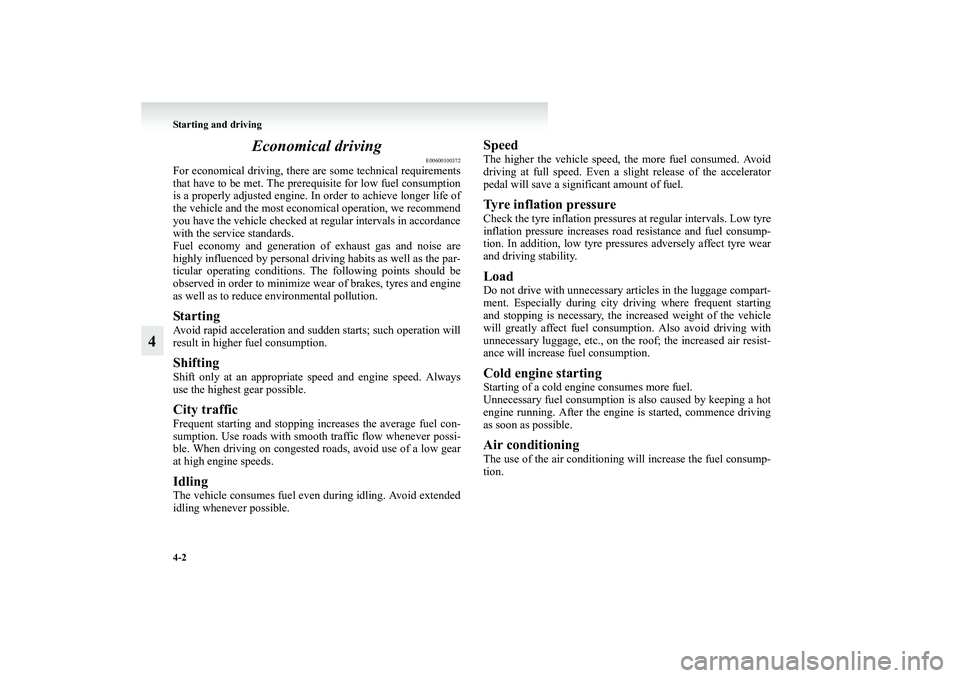
4-2 Starting and driving
4Economical driving
E00600100372
For economical driving, there are some technical requirements
that have to be met. The prerequisite for low fuel consumption
is a properly adjusted engine. In order to achieve longer life of
the vehicle and the most economical operation, we recommend
you have the vehicle checked at regular intervals in accordance
with the service standards.
Fuel economy and generation of exhaust gas and noise are
highly influenced by personal driving habits as well as the par-
ticular operating conditions. The following points should be
observed in order to minimize wear of brakes, tyres and engine
as well as to reduce environmental pollution.StartingAvoid rapid acceleration and sudden starts; such operation will
result in higher fuel consumption.ShiftingShift only at an appropriate speed and engine speed. Always
use the highest gear possible.City trafficFrequent starting and stopping increases the average fuel con-
sumption. Use roads with smooth traffic flow whenever possi-
ble. When driving on congested roads, avoid use of a low gear
at high engine speeds.IdlingThe vehicle consumes fuel even during idling. Avoid extended
idling whenever possible.
SpeedThe higher the vehicle speed, the more fuel consumed. Avoid
driving at full speed. Even a slight release of the accelerator
pedal will save a significant amount of fuel.Tyre inflation pressureCheck the tyre inflation pressures at regular intervals. Low tyre
inflation pressure increases road resistance and fuel consump-
tion. In addition, low tyre pressures adversely affect tyre wear
and driving stability.LoadDo not drive with unnecessary articles in the luggage compart-
ment. Especially during city driving where frequent starting
and stopping is necessary, the increased weight of the vehicle
will greatly affect fuel consumption. Also avoid driving with
unnecessary luggage, etc., on the roof; the increased air resist-
ance will increase fuel consumption.Cold engine startingStarting of a cold engine consumes more fuel.
Unnecessary fuel consumption is also caused by keeping a hot
engine running. After the engine is started, commence driving
as soon as possible.Air conditioningThe use of the air conditioning will increase the fuel consump-
tion.
BK-XP08E1ENUK.en-uk.book Page 2 Monday, August 13, 2007 2:20 PM
Page 175 of 458
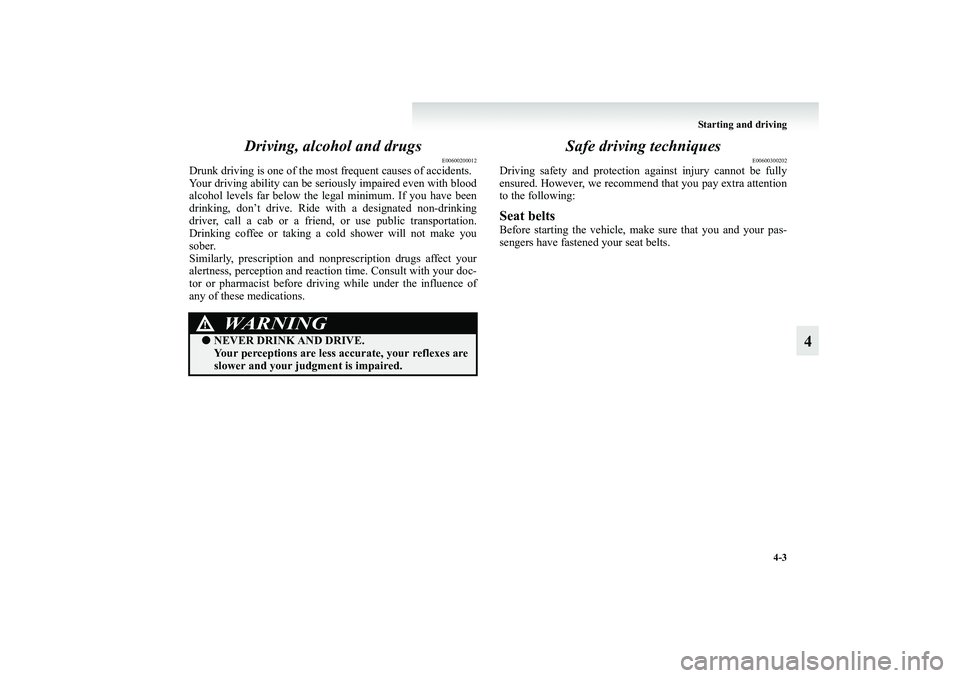
Starting and driving
4-3
4 Driving, alcohol and drugs
E00600200012
Drunk driving is one of the most frequent causes of accidents.
Your driving ability can be seriously impaired even with blood
alcohol levels far below the legal minimum. If you have been
drinking, don’t drive. Ride with a designated non-drinking
driver, call a cab or a friend, or use public transportation.
Drinking coffee or taking a cold shower will not make you
sober.
Similarly, prescription and nonprescription drugs affect your
alertness, perception and reaction time. Consult with your doc-
tor or pharmacist before driving while under the influence of
any of these medications.
Safe driving techniques
E00600300202
Driving safety and protection against injury cannot be fully
ensured. However, we recommend that you pay extra attention
to the following:Seat beltsBefore starting the vehicle, make sure that you and your pas-
sengers have fastened your seat belts.
WARNING
!â—ŹNEVER DRINK AND DRIVE.
Your perceptions are less accurate, your reflexes are
slower and your judgment is impaired.
BK-XP08E1ENUK.en-uk.book Page 3 Monday, August 13, 2007 2:20 PM
Page 176 of 458
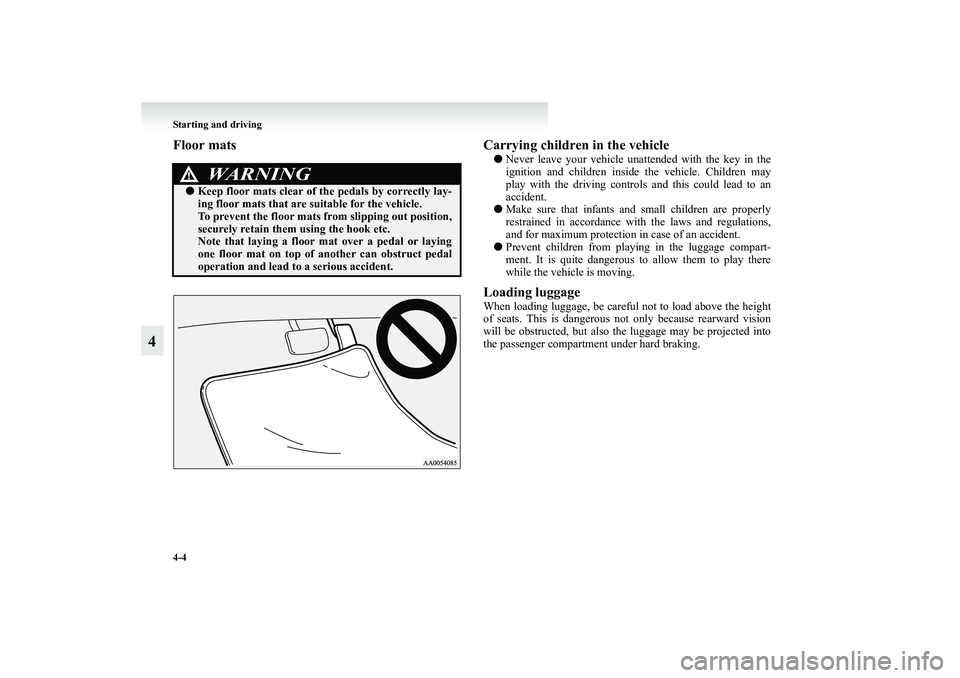
4-4 Starting and driving
4
Floor mats Carrying children in the vehicle
â—ŹNever leave your vehicle unattended with the key in the
ignition and children inside the vehicle. Children may
play with the driving controls and this could lead to an
accident.
â—ŹMake sure that infants and small children are properly
restrained in accordance with the laws and regulations,
and for maximum protection in case of an accident.
â—ŹPrevent children from playing in the luggage compart-
ment. It is quite dangerous to allow them to play there
while the vehicle is moving.Loading luggageWhen loading luggage, be careful not to load above the height
of seats. This is dangerous not only because rearward vision
will be obstructed, but also the luggage may be projected into
the passenger compartment under hard braking.
WARNING
!â—ŹKeep floor mats clear of the pedals by correctly lay-
ing floor mats that are suitable for the vehicle.
To prevent the floor mats from slipping out position,
securely retain them using the hook etc.
Note that laying a floor mat over a pedal or laying
one floor mat on top of another can obstruct pedal
operation and lead to a serious accident.
BK-XP08E1ENUK.en-uk.book Page 4 Monday, August 13, 2007 2:20 PM
Page 177 of 458
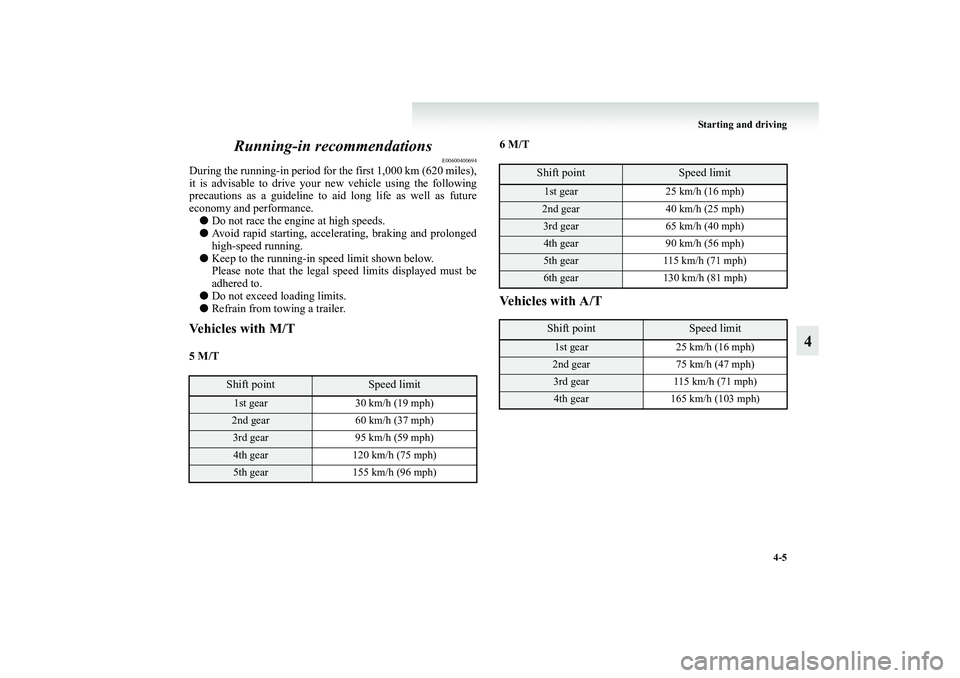
Starting and driving
4-5
4 Running-in recommendations
E00600400694
During the running-in period for the first 1,000 km (620 miles),
it is advisable to drive your new vehicle using the following
precautions as a guideline to aid long life as well as future
economy and performance.
â—ŹDo not race the engine at high speeds.
â—ŹAvoid rapid starting, accelerating, braking and prolonged
high-speed running.
â—ŹKeep to the running-in speed limit shown below.
Please note that the legal speed limits displayed must be
adhered to.
â—ŹDo not exceed loading limits.
â—ŹRefrain from towing a trailer.Vehicles with M/T5 M/T
6 M/T
Vehicles with A/T
Shift point
Speed limit
1st gear 30 km/h (19 mph)2nd gear 60 km/h (37 mph)3rd gear 95 km/h (59 mph)4th gear 120 km/h (75 mph)5th gear 155 km/h (96 mph)
Shift point
Speed limit
1st gear 25 km/h (16 mph)2nd gear 40 km/h (25 mph)3rd gear 65 km/h (40 mph)4th gear 90 km/h (56 mph)5th gear 115 km/h (71 mph)6th gear 130 km/h (81 mph)Shift point
Speed limit
1st gear 25 km/h (16 mph)2nd gear 75 km/h (47 mph)3rd gear 115 km/h (71 mph)4th gear 165 km/h (103 mph)
BK-XP08E1ENUK.en-uk.book Page 5 Monday, August 13, 2007 2:20 PM
Page 178 of 458
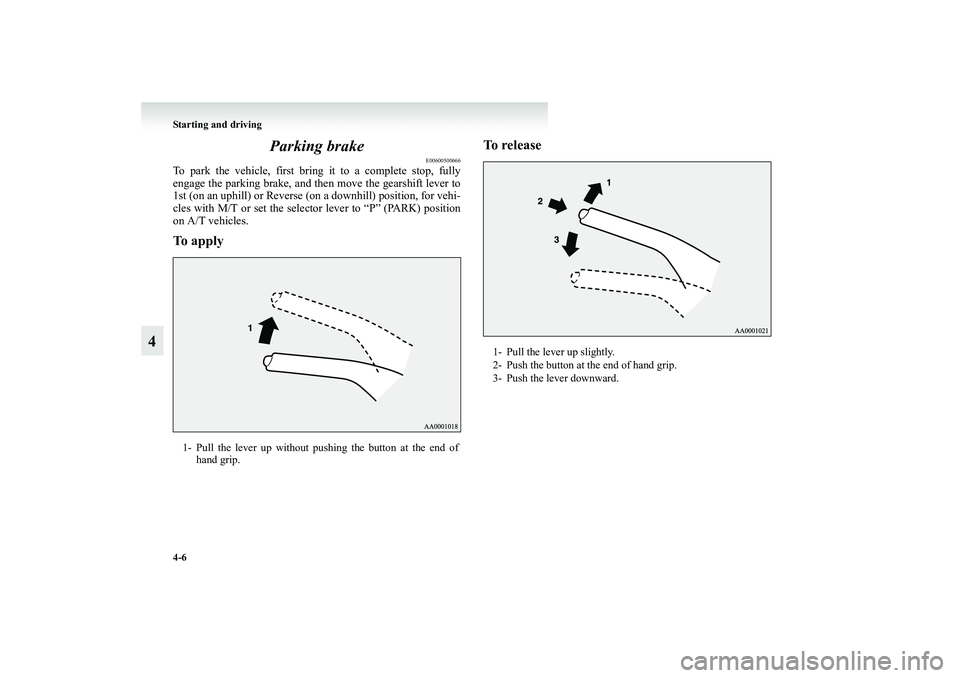
4-6 Starting and driving
4Parking brake
E00600500666
To park the vehicle, first bring it to a complete stop, fully
engage the parking brake, and then move the gearshift lever to
1st (on an uphill) or Reverse (on a downhill) position, for vehi-
cles with M/T or set the selector lever to “P” (PARK) position
on A/T vehicles.To applyTo release1- Pull the lever up without pushing the button at the end of
hand grip.
1- Pull the lever up slightly.
2- Push the button at the end of hand grip.
3- Push the lever downward.
BK-XP08E1ENUK.en-uk.book Page 6 Monday, August 13, 2007 2:20 PM
Page 179 of 458
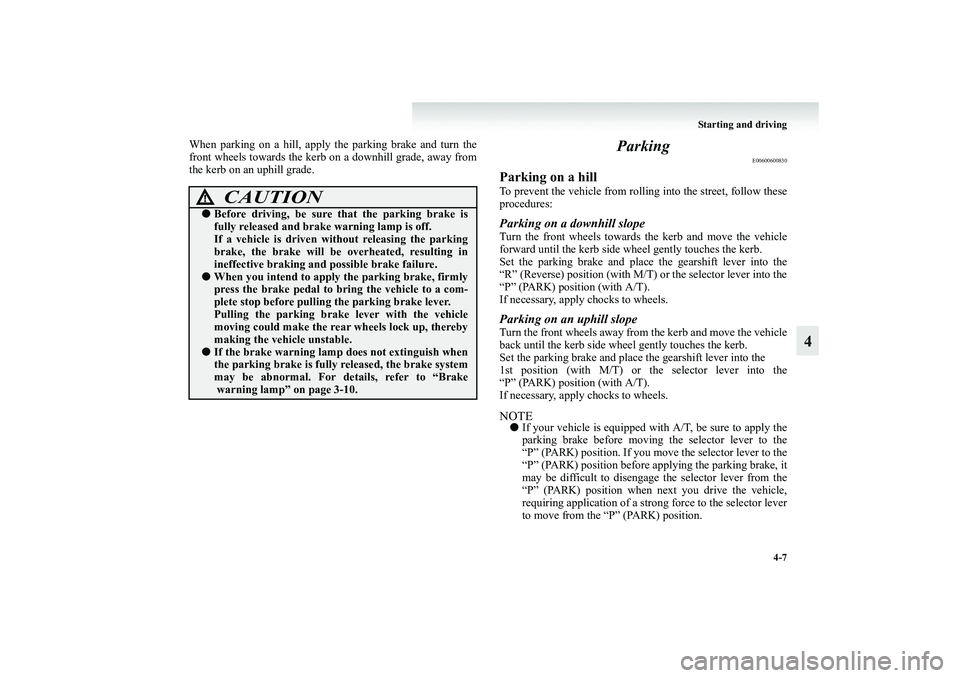
Starting and driving
4-7
4
When parking on a hill, apply the parking brake and turn the
front wheels towards the kerb on a downhill grade, away from
the kerb on an uphill grade.
Parking
E00600600830
Parking on a hillTo prevent the vehicle from rolling into the street, follow these
procedures:Parking on a downhill slopeTurn the front wheels towards the kerb and move the vehicle
forward until the kerb side wheel gently touches the kerb.
Set the parking brake and place the gearshift lever into the
“R” (Reverse) position (with M/T) or the selector lever into the
“P” (PARK) position (with A/T).
If necessary, apply chocks to wheels.Parking on an uphill slopeTurn the front wheels away from the kerb and move the vehicle
back until the kerb side wheel gently touches the kerb.
Set the parking brake and place the gearshift lever into the
1st position (with M/T) or the selector lever into the
“P” (PARK) position (with A/T).
If necessary, apply chocks to wheels.NOTEâ—ŹIf your vehicle is equipped with A/T, be sure to apply the
parking brake before moving the selector lever to the
“P” (PARK) position. If you move the selector lever to the
“P” (PARK) position before applying the parking brake, it
may be difficult to disengage the selector lever from the
“P” (PARK) position when next you drive the vehicle,
requiring application of a strong force to the selector lever
to move from the “P” (PARK) position.
CAUTION
!â—ŹBefore driving, be sure that the parking brake is
fully released and brake warning lamp is off.
If a vehicle is driven without releasing the parking
brake, the brake will be overheated, resulting in
ineffective braking and possible brake failure.â—ŹWhen you intend to apply the parking brake, firmly
press the brake pedal to bring the vehicle to a com-
plete stop before pulling the parking brake lever.
Pulling the parking brake lever with the vehicle
moving could make the rear wheels lock up, thereby
making the vehicle unstable.â—ŹIf the brake warning lamp does not extinguish when
the parking brake is fully released, the brake system
may be abnormal. For details, refer to “Brake
warning lamp” on page 3-10.
BK-XP08E1ENUK.en-uk.book Page 7 Monday, August 13, 2007 2:20 PM
Page 180 of 458
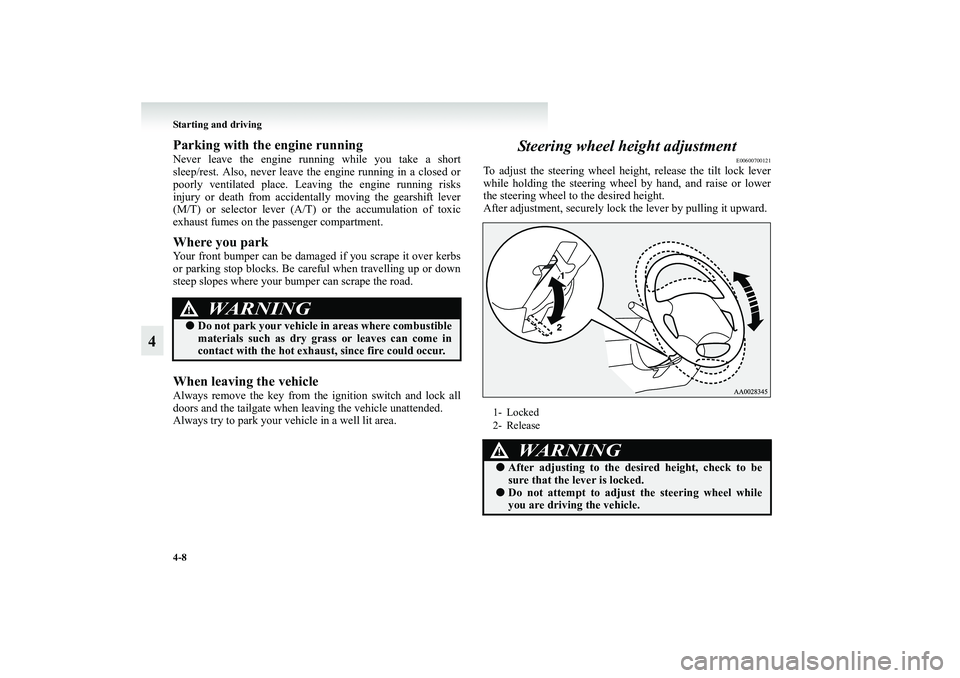
4-8 Starting and driving
4
Parking with the engine runningNever leave the engine running while you take a short
sleep/rest. Also, never leave the engine running in a closed or
poorly ventilated place. Leaving the engine running risks
injury or death from accidentally moving the gearshift lever
(M/T) or selector lever (A/T) or the accumulation of toxic
exhaust fumes on the passenger compartment.Where you parkYour front bumper can be damaged if you scrape it over kerbs
or parking stop blocks. Be careful when travelling up or down
steep slopes where your bumper can scrape the road.When leaving the vehicleAlways remove the key from the ignition switch and lock all
doors and the tailgate when leaving the vehicle unattended.
Always try to park your vehicle in a well lit area.
Steering wheel height adjustment
E00600700121
To adjust the steering wheel height, release the tilt lock lever
while holding the steering wheel by hand, and raise or lower
the steering wheel to the desired height.
After adjustment, securely lock the lever by pulling it upward.
WARNING
!â—ŹDo not park your vehicle in areas where combustible
materials such as dry grass or leaves can come in
contact with the hot exhaust, since fire could occur.
1- Locked
2- Release
WARNING
!â—ŹAfter adjusting to the desired height, check to be
sure that the lever is locked.â—ŹDo not attempt to adjust the steering wheel while
you are driving the vehicle.
BK-XP08E1ENUK.en-uk.book Page 8 Monday, August 13, 2007 2:20 PM